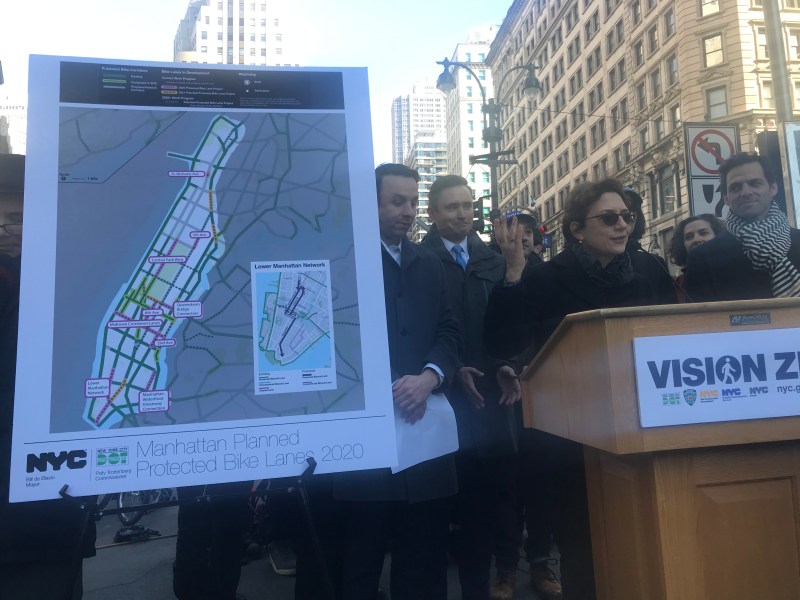Ten Miles of Protected Bike Lanes Coming To Manhattan This Year
DOT will close the dangerous gaps on Sixth and Second avenues as CPW, others, get life-saving extensions.

The city will finally close the notoriously dangerous gap in the Sixth Avenue bike lane this year, officials said at a Manhattan press conference Wednesday — after years of efforts from cycling and street-safety advocates to make a connected, safe bicycle network in the borough.
The Department of Transportation announced its plan to build 10 miles of protected bike lanes in Manhattan — a third of the 30 miles the city promised to install citywide this year as part of the de Blasio administration’s “Green Wave” plan, announced last summer amid a rash of cyclist fatalities.
Just last month, two dozen street-safety advocates marched up Sixth Avenue — dubbed the “road to nowhere” — demanding transportation bigwigs finish installing the protected bike lane on the avenue so that there is no longer a gap between 33rd Street and the entrance to car-free Central Park.
And on Wednesday, they listened.
“The ‘road to nowhere’ is now truly becoming the road to safety and opportunity for all New Yorkers,” said Transportation Alternatives Executive Director Danny Harris during the press conference at the corner of Sixth Avenue and 34th Street.
The “road to nowhere” is going to become a road to somewhere — this year! @NYC_DOT has committed to #Fix6th Ave and extend the protected bike lane up to Central Park. pic.twitter.com/mJEVw9HIDL
— Transportation Alternatives (@TransAlt) February 19, 2020
Bike New York’s Jon Orcutt hailed the forthcoming key improvements, especially closing the Sixth Avenue gap, as the “holy grail.”
In addition to Sixth Avenue, the DOT will also close up the unprotected stretch on Second Avenue. between 43rd and 34th streets, once the city’s Department of Design and Construction to wrap up its own project in the area.
The full list of projects coming to Manhattan in 2020 includes:
- Sixth Avenue from Herald Square to Central Park,
- Extending Central Park West to 110th Street,
- Fifth Avenue from 110th to 120th Streets, connecting Central Park and Marcus Garvey Park,
- Saint Nicholas Avenue between 165th and 170th Streets.
- Creating a Manhattan Waterfront Greenway connection with a new protected route in Alphabet City that will accommodate riders during the East River Park reconstruction,
- Filling in several corridors, including on lower Broadway, Whitehall Street, West Broadway, Varick Street, Church Street and 6th Avenue,
- Adding several crosstown protected bike-lane connections to the Queensboro Bridge, and
- Adding a set of crosstown lanes on yet-to-be determined streets.
StreetsPac’s Hilda Cohen said that making popular routes such as Sixth Avenue truly protected is crucial, especially for working cyclists who rely on them in order to deliver goods. Last year, 20-year-old Robyn Hightman, a delivery cyclist, was killed by a truck driver on the avenue near 23rd Street.
“Making space for working cyclists is always important,” said Cohen.
And redesigning streets to make way for protected bike lanes not only makes them safer for bikers, but also for pedestrians, who are also forced to fight for space among speeding cars, said Manhattan Council Member Keith Powers.
“[It’s] not just about biking; it creates safety for everybody,” Powers said.
Streetsblog reported last month that there have been 1,779 collisions in the unprotected portion of Sixth Avenue since January, 2017, injuring 64 cyclists, 90 pedestrians and 108 motorists, and killing a pedestrian.
Yet, even with the protected bike lane further south, Sixth Avenue isn’t the safe haven it should be — both working-cyclist Hightman and pedestrian Michael Collopy were killed near W. 23rd Street in 2019 because more room is devoted to moving and storing cars and trucks than the pedestrians and cyclists who often outnumber the vehicles.
Powers told Streetsblog at the time that, in addition to finishing the protected bike lane, the city must also look to expand pedestrian space.
“There’s a high demand for a bike lane here, but this is a perfect area … to expand some of the sidewalk and curb space to give people an easier way to get around the streets,” he said.
DOT Commissioner Polly Trottenberg also dropped the bombshell news — after questioning from Streetsblog — that the last phase of the Queens Boulevard bike lane between Yellowstone Boulevard and Union Turnpike in Forest Hills, which has been stalled since 2018, will be completed this summer. (The mayor may have undermined her at a town hall in Queens hours later, however.)
Breaking News: @NYC_DOT Commissioner Polly Trottenberg just announced that they will #FinishQueensBlvd THIS SUMMER!!!!!!! @FixQueensBlvd #bikenyc #BikeQNS
— Laura Shepard (@LAShepard221) February 19, 2020
The new protected bike lanes coming soon to Manhattan come on the heels of DOT’s announcement last month Brooklyn is also slated to get 10 miles of new protected bike lanes this year.






